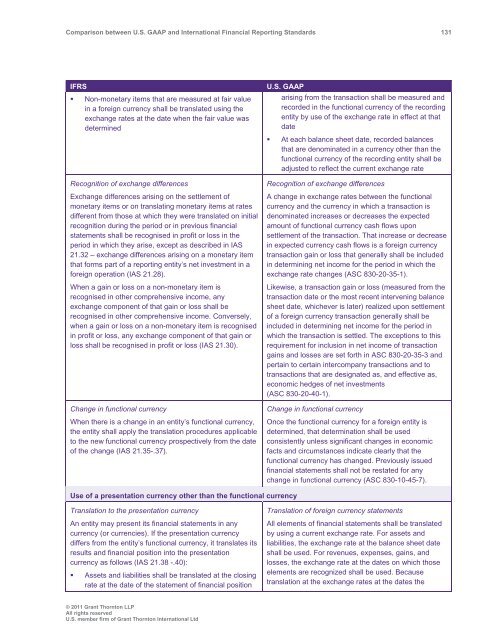Comparison between U.S. GAAP and International ... - Grant Thornton
Comparison between U.S. GAAP and International ... - Grant Thornton
Comparison between U.S. GAAP and International ... - Grant Thornton
Create successful ePaper yourself
Turn your PDF publications into a flip-book with our unique Google optimized e-Paper software.
<strong>Comparison</strong> <strong>between</strong> U.S. <strong>GAAP</strong> <strong>and</strong> <strong>International</strong> Financial Reporting St<strong>and</strong>ards 131<br />
IFRS<br />
• Non-monetary items that are measured at fair value<br />
in a foreign currency shall be translated using the<br />
exchange rates at the date when the fair value was<br />
determined<br />
Recognition of exchange differences<br />
Exchange differences arising on the settlement of<br />
monetary items or on translating monetary items at rates<br />
different from those at which they were translated on initial<br />
recognition during the period or in previous financial<br />
statements shall be recognised in profit or loss in the<br />
period in which they arise, except as described in IAS<br />
21.32 – exchange differences arising on a monetary item<br />
that forms part of a reporting entity’s net investment in a<br />
foreign operation (IAS 21.28).<br />
When a gain or loss on a non-monetary item is<br />
recognised in other comprehensive income, any<br />
exchange component of that gain or loss shall be<br />
recognised in other comprehensive income. Conversely,<br />
when a gain or loss on a non-monetary item is recognised<br />
in profit or loss, any exchange component of that gain or<br />
loss shall be recognised in profit or loss (IAS 21.30).<br />
Change in functional currency<br />
When there is a change in an entity’s functional currency,<br />
the entity shall apply the translation procedures applicable<br />
to the new functional currency prospectively from the date<br />
of the change (IAS 21.35-.37).<br />
U.S. <strong>GAAP</strong><br />
arising from the transaction shall be measured <strong>and</strong><br />
recorded in the functional currency of the recording<br />
entity by use of the exchange rate in effect at that<br />
date<br />
• At each balance sheet date, recorded balances<br />
that are denominated in a currency other than the<br />
functional currency of the recording entity shall be<br />
adjusted to reflect the current exchange rate<br />
Recognition of exchange differences<br />
A change in exchange rates <strong>between</strong> the functional<br />
currency <strong>and</strong> the currency in which a transaction is<br />
denominated increases or decreases the expected<br />
amount of functional currency cash flows upon<br />
settlement of the transaction. That increase or decrease<br />
in expected currency cash flows is a foreign currency<br />
transaction gain or loss that generally shall be included<br />
in determining net income for the period in which the<br />
exchange rate changes (ASC 830-20-35-1).<br />
Likewise, a transaction gain or loss (measured from the<br />
transaction date or the most recent intervening balance<br />
sheet date, whichever is later) realized upon settlement<br />
of a foreign currency transaction generally shall be<br />
included in determining net income for the period in<br />
which the transaction is settled. The exceptions to this<br />
requirement for inclusion in net income of transaction<br />
gains <strong>and</strong> losses are set forth in ASC 830-20-35-3 <strong>and</strong><br />
pertain to certain intercompany transactions <strong>and</strong> to<br />
transactions that are designated as, <strong>and</strong> effective as,<br />
economic hedges of net investments<br />
(ASC 830-20-40-1).<br />
Change in functional currency<br />
Once the functional currency for a foreign entity is<br />
determined, that determination shall be used<br />
consistently unless significant changes in economic<br />
facts <strong>and</strong> circumstances indicate clearly that the<br />
functional currency has changed. Previously issued<br />
financial statements shall not be restated for any<br />
change in functional currency (ASC 830-10-45-7).<br />
Use of a presentation currency other than the functional currency<br />
Translation to the presentation currency<br />
An entity may present its financial statements in any<br />
currency (or currencies). If the presentation currency<br />
differs from the entity’s functional currency, it translates its<br />
results <strong>and</strong> financial position into the presentation<br />
currency as follows (IAS 21.38 -.40):<br />
• Assets <strong>and</strong> liabilities shall be translated at the closing<br />
rate at the date of the statement of financial position<br />
Translation of foreign currency statements<br />
All elements of financial statements shall be translated<br />
by using a current exchange rate. For assets <strong>and</strong><br />
liabilities, the exchange rate at the balance sheet date<br />
shall be used. For revenues, expenses, gains, <strong>and</strong><br />
losses, the exchange rate at the dates on which those<br />
elements are recognized shall be used. Because<br />
translation at the exchange rates at the dates the<br />
© 2011 <strong>Grant</strong> <strong>Thornton</strong> LLP<br />
All rights reserved<br />
U.S. member firm of <strong>Grant</strong> <strong>Thornton</strong> <strong>International</strong> Ltd
















